(Strand)om Stories: The Infinity Watch (vol. 1) Review
This volume introduces a series laced with potential tension and characterization, becoming unbalanced as it dives deeper into cosmic events
—by Nathan on October 23, 2023—
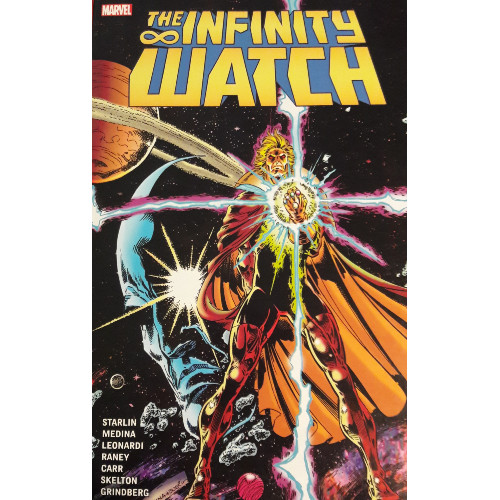
Thanos, the Mad Titan, with divinity in the palm of his hand, had snuffed out half of all existence across the universe. Adam Warlock, leading a coalition of Earth’s mightiest heroes and a band of cosmic deities, had thwarted Thanos’ godhood and reclaimed the fabled Infinity Gauntlet. And so Jim Starlin wrapped up his decades-long space saga, wiped the cosmic dust from his hands, and sat back, hands behind his head, feet crossed on his desk.
All was good in the universe.
Except…not completely.
Starlin’s Infinity Gauntlet limited series ended with Warlock in possession of the titular golden MacGuffin and control of space, time, reality, power, the mind, and the soul. The universe had witnessed–literally, its physical embodiment Eternity had seen–the devastation wrought by one being wielding all six gems. It mattered not that Warlock was a golden guardian of good. Once upon a time, he'd battled a different purple potentate, a twisted version of himself from the future. What if Warlock went bad? The universe shuddered to think.
So a cosmic council convened and determined the Infinity Gems should be split up, assigning Warlock the responsibility of finding suitable guardians. Which isn’t hard. Warlock has a couple buddies he can call up.
Infinity Watch (vol. 1)
Writer: Jim Starlin
Pencilers: Angel Medina, Rick Leonardi, Tom Raney, Tom Grindberg, Steve Carr, and Daryl Skelton
Inkers: Terry Austin, Bon Almond, and Keith Williams
Colorists: Ian Laughlin and Renée Witterstaetter
Letterers: Jack Morelli, Janice Chiang, Ken Lopez, and Jon Babcock
Issues Collected: Warlock and the Infinity Watch #1-22
Volume Publication Date: March 2016
Issue Publication Dates: February 1992-November 1993
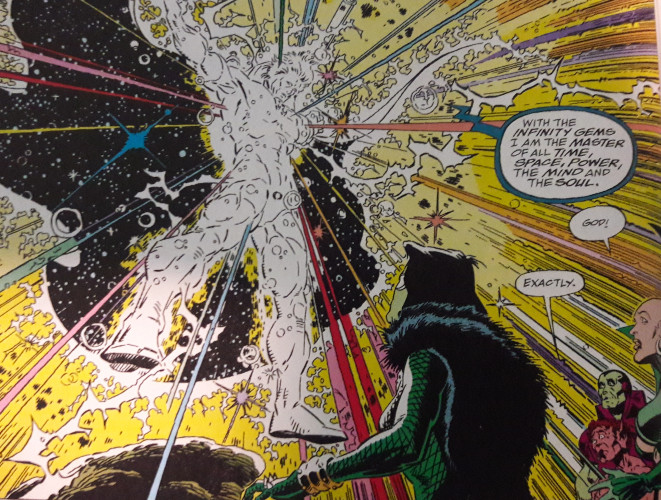
Warlock wrangles himself up quite the crew to take possession of the Infinity Gems–himself, Gamora, Drax the Destroyer, Pip the Troll, Moondragon…and a, enigmatic sixth member, the mystery of whom flits around in the background.
From nearly the very beginning of the series, you get a sense that Starlin wishes to capitalize on the team dynamics, quickly establishing the core relationships and tensions which will drive our central characters as they encounter new mysteries and adversaries. Warlock and Gamora work through tensions left over from a previous relationship; Moondragon struggles connecting with Drax, who was her father before his transformation into a green behemoth; Thanos lodges himself into the series, playing the role of a seeming ally yet stirring old memories from his days as Gamora’s adopted father as well as his recent stint as a universe-devastating despot. Founded on Starlin’s work from past decades, the series strives to continue its central characters’ personal narratives even as it flings them hither-and-yon through the universe. If, like me, you were somewhat disappointed by Starlin's team work over at DC, rest assured: he's got a better handle on his heroes here...mostly.
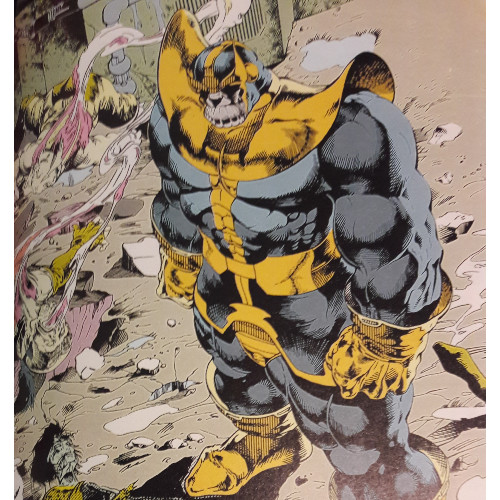
The core characters and the series’ premise ("one Infinity Gem for for one Infinity Watch member") seem to be all that Starlin drafted before writing the series, as Infinity Watch quickly loses a central focus despite its foundational protagonists. Opening with an arc dedicated to reintroducing characters from before even Starlin’s time on Warlock’s first series, Infinity Watch soon becomes embroiled in Starlin’s Infinity Gauntlet sequels, Infinity War and Infinity Crusade, both of which I will discuss in future in "Spider-view" posts. Starlin, by this point, hasn’t done much to create an overarching story through Infinity Watch, so you never feel like he’s interrupting his own narrative. But whatever progress has been made is overshadowed by the need to weave his heroes into these larger projects. Because Starlin oversees the central crossover series himself, Infinity Watch feels more integral to those narratives, but at the same time, because the series contributes only tie-in issues to the crossover, we’re given only snippets of a larger story. Big things happen elsewhere, leaving you scrambling to glue the pieces together and imagine the bits and bobs which are missing.
The plot becomes aimless, tempestuous, almost at war with itself. It’s not dissimilar to Starlin’s run on Strange Tales (which subsequently became Warlock), which felt structured and intentional through the "Magus" epic; once that plotline was finished, however, the rest of the series drifted like an asteroid through space, moving along on some mindless trail, with no real purpose but motion. Infinity Watch is punctuated by plot developments–Warlock’s return to Counter Earth, the Watch seeking solace with the Mole Man, a brief stand against United Nations troops–yet otherwise becomes embroiled in external narratives. This leads Infinity Watch to feel disjointed, somewhat fragmented, as I pointed out above.
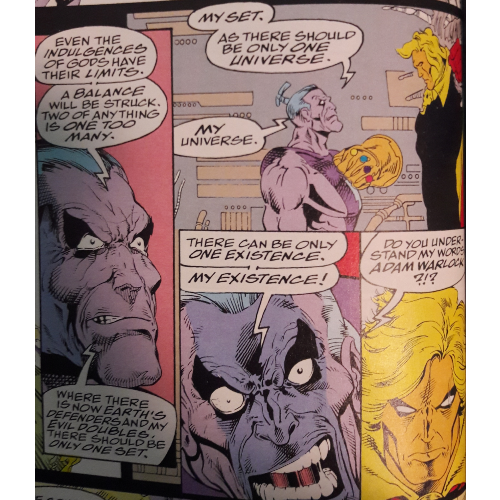
Starlin’s strongest issues focus on individual members, offering them deeper personality than when they’re together or yanked into universe-altering epics. Gamora reflects on her past and her relationship with Thanos, which was downright fatherly at times until she betrayed him. Drax is given a brief personal arc where he, momentarily, attempts to reconnect with the man he was prior to his transformation, strands of thought and personality whirling around his fragmented, often confused mind. Warlock goes through a wandering stage where he reflects on who he’s been through the years, not so dissimilar to the soul-searching Starlin had him encounter in his own series.
Starlin is responsible for creating three of the five members of the Watch (Drax, Gamora, and Pip), giving subplots like Gamora’s reflection on her upbringing additional weight, but his use of Warlock stems from how well he (generally) handled the character in his own series. Starlin’s allowed to linger, just briefly, with his golden-hued hero for the first time in nearly fifteen years; after being imprisoned in the Soul Gem following Thanos’ defeat in Marvel Two-in-One Annual #2, Warlock languished until being freed during Gauntlet, where he spent most of his time plotting against the Mad Titan’s fabled stab at godhood, lurking in the shadows. Starlin can bring back some of Warlock’s trademark musings of life and existence, getting glimpses of former selves as he continues pondering the question of who he is. As noted above, this allows Starlin the opportunity to continue digging into the character beyond the scope of his original run on the character, extracting a bit more depth now that time has passed and significant events have taken place.
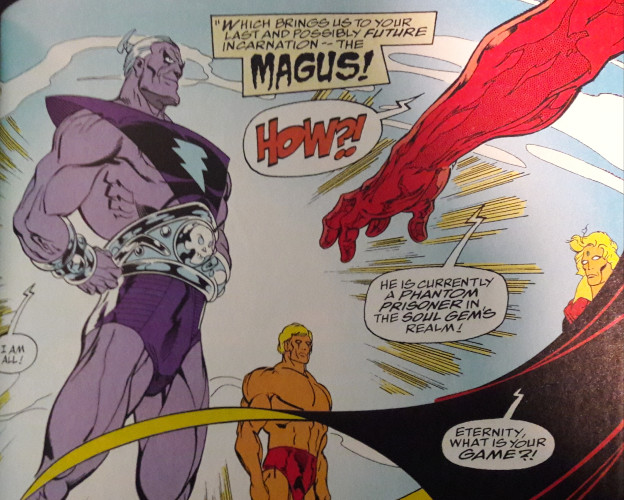
Much like Infinity Gauntlet was a culmination of the work Starlin contributed to Captain Marvel, Warlock, and Silver Surfer, Infinity Watch is a continuation of the aftermath of the assembled Marvel stable of heroes against Thanos–we now walk amongst the fleeing shadows of a god’s mad designs, asking what must be done with the power he wielded. Starlin makes do with the distribution of the Infinity Gems, but for all the preening over the baubles, his pace leaves very little room to ruminate on their capabilities. It’s that annoying pace established by the creation of Infinity Gauntlet sequels, forcing Starlin to work in the crevices. There’s no naturally forming narrative pathway Starlin can carve through the series, much like he did with years of characterization and (possibly unintentional) foreshadowing leading up to Thanos’ finest hour. I can assume the sales of Gauntlet demanded the quick creation of sequel events, much like the original (and subjectively stupendous) Secret Wars gave birth to its somewhat lopsided, lackluster child, Secret Wars II. In this way, Infinity Watch feels more like a bridge between events rather than its own series, sidelining development of its central cast and their newly acquired baubles for mesmerizing action sequences which rattle the galaxy.
This volume concludes tangled in the narrative web of Crusade, and I can only imagine the second volume (which I do intend on reviewing down the line) is in less of a morass. Though I didn’t indicate in the title or intro, this review serves as a prelude to War, which is up next in my "Spider-view" series. So even though this volume careens across both crossovers, take the important stuff with you as you leave: the Infinity Gems are divided, and evil stalks the starways once more. From a corporate standpoint, I can see the angle Marvel went for, capitalizing on Starlin’s compelling space sagas; from a reader perspective, I choose to focus on the kerfuffle created by event extravaganzas and how they interrupt most of the character-driven qualities of this series. I wanted more moments between Gamora and Thanos, more of Drax understanding who he was before his transformation, more of the Watch wrestling with their gem-granted abilities and the responsibility which comes with wielding such power...even the resolution of that mysterious sixth member. Instead, we get some centering seconds, brief as a span of heartbeats, before it’s back to the romp and ruin of company-wide crossovers.